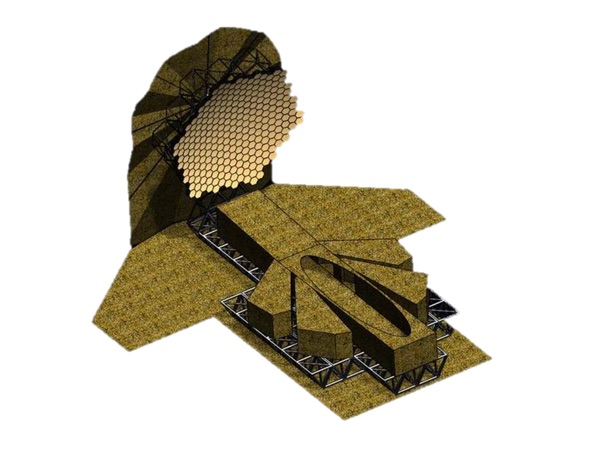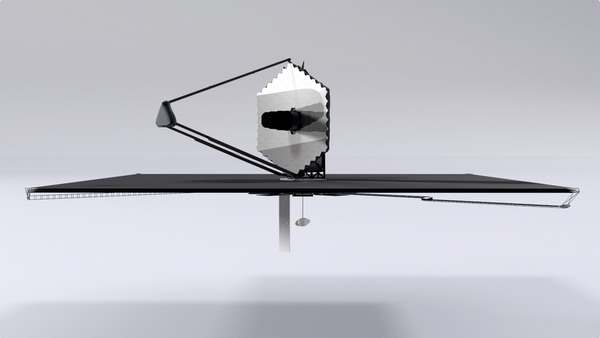Repairing, and building, future space telescopesby Jeff Foust
|
| “We can’t build telescopes that cost $10 billion plus and then abandon them after ten years,” said Peterson. “That’s just irresponsible.” |
Managers were optimistic that WFC3 would soon be back online. “Have no fear, that will be up again soon,” said Tom Brown, Hubble mission manager at the Space Telescope Science Institute, during a session devoted to the future of the telescope at the 233rd Meeting of the American Astronomical Society (AAS) last week in Seattle. Potential fixes to the problem ranged from a simple reset of the camera’s electronics to switching to a redundant set of electronics.
It served as a reminder, though, that Hubble’s future is finite. The telescope, launched in 1990, has been repaired and enhanced through a series of servicing missions, the last of which flew in 2009. Hubble has had some technical problems in the recent past, including a failed gyro in October that took the entire observatory offline for three weeks.
Brown, though, was confident that Hubble would continue to operate for years to come. Engineering projections indicate that, despite recent issues, the spacecraft’s instruments and major subsystems will remain operational well into the 2020s. He noted there are plans to switch from the current three-gyro mode for pointing Hubble to a one-gyro mode after the next gyro failure, allowing the two remaining gyros to be used consecutively to extend the spacecraft’s life.
“We expect Hubble to be scientifically productive far into the next decade,” Brown said.
NASA is relearning the importance of satellite servicing for future space observatories. While Hubble was designed from the very beginning to be serviced by the space shuttle, its successor, the James Webb Space Telescope (JWST), is not designed for servicing. Part of that has to do with JWST’s location at the Earth-Sun L2 Lagrange point, 1.5 million kilometers from Earth, compared to Hubble’s location in low Earth orbit, easily accessible by the now-retired shuttle.
That’s understandably created nervousness about JWST’s complex process of deploying its mirrors and sunshield after launch (exacerbated by its delays and cost overruns.) But even if its deployment is successful, there’s still the issue of a lifetime limited by failures of instruments or other components, as well as exhausting its supply of propellant needed to maintain its position at L2. Some have suggested it might be possible to carry out some kind of robotic servicing mission to at least refuel JWST, but that could be challenging given the lack of support for servicing built into the spacecraft, and concerns outgassing from any servicing spacecraft might contaminate JWST’s optics.
“We can’t build telescopes that cost $10 billion plus and then abandon them after ten years,” said Bradley Peterson, an astronomer at Ohio State University and the Space Telescope Science Institute, during another session of the AAS conference last week. “That’s just irresponsible.”
Future large space telescopes will have support for servicing, starting with the Wide-Field Infrared Survey Telescope (WFIRST). The modularity that servicing requires does come at a price, but proponents argue that its benefits more than outweigh its costs.
“The initial look-through to make it modular to allow it to be serviced increased its cost by about $23 million,” recalled John Grunsfeld, the former astronaut who flew on several Hubble servicing missions and later served as NASA associate administrator for science. “The analysis was that we could save probably five times that during integration and test since everything is modular and easier to get at.”
Servicing is likely to be a requirement for the next large space telescope to follow WFIRST. Studies of four such missions, spanning the electromagnetic spectrum from x-rays to the infrared, are nearing completion. Those mission concepts will be considered by the next decadal survey in astrophysics, which is scheduled to complete its report prioritizing missions for the next decade in late 2020.
| “There have been a lot of technology and engineering developments in the last decade that are moving things in the right direction” for in-space assembly of telescopes, said Polidan. |
The top-priority large mission to come out of the decadal survey, if NASA chooses to develop it, likely won’t launch until at least the mid-2030s. However, astronomers are already starting to think about what comes next, and the limitations that current and proposed launch vehicles will place on them.
Peterson noted that the largest of the four missions under consideration for the 2020 decadal survey, called the Large Ultraviolet/Optical/Infrared Surveyor, or LUVOIR, has a primary mirror 15 meters in diameter. (An alternative version of the telescope, LUVOIR-B, has a mirror eight meters across.) Even when folded up for launch, LUVOIR is so large that it could only be launched on Block 2 version of the Space Launch System.
“The 15-meter version of LUVOIR is the largest aperture that we can put into an SLS Block 2 fairing,” Peterson said. “That’s the largest telescope you can get into space with a single launch.”
Peterson, Grunsfeld, and others spoke at an AAS conference session devoted to an ongoing study of in-space assembly, rather than servicing, of space telescopes. With astronomers interested in ever-larger telescopes to peer back to the earliest ages of the universe or study potential Earth-like exoplanets, the ability to build telescopes in space, instead of just repairing them, will be essential. “In-space assembly is really not a question of if, it’s a question of when,” Peterson said.
“There have been a lot of technology and engineering developments in the last decade that are moving things in the right direction” for in-space assembly of telescopes, said Ron Polidan, one of the members of the study team. Those includes a growing number of options for low-cost launch, development of robotic systems, and other emerging technologies, like in-space manufacturing. “We live in a fairly disruptive time.”
 An illustration of a notional 20-meter space telescope that would be launched in modules and assembled in space. (credit: NASA) |
The effort, formally known as the NASA in-Space Assembled Telescope (iSAT) Study, has at its core a single question: “When is it worth assembling space telescopes in space rather than building them on the Earth?” said Nick Siegler, one of the leads of the study.
One part of the study examines in-space assembly as an enabling technology; that is, cases where a space telescope couldn’t be built without assembling it in orbit, like those bigger tha LUVOIR. A second part of the study will examine in-space assembly as an enhancing technology for telescopes that could still be built on the ground and launched in a single piece. Those enhancements, Siegler said, could range from eliminating complex deployment operations to leveraging lower-cost launch options by launching the telescope in modules that are assembled in space.
A notional concept being considered by the iSAT study is for a 20-meter telescope. That design, he said, could be split into 73 modules, from mirror segments to instruments, that are flown on 10 to 12 launches and then assembled in space. “Someone mentioned to me that it looked like a thunderbird,” he said, referring to the mythological bird and not the automobile. “I kind of see the resemblance.”
The study team plans to refine that concept and estimate its cost, and then scale it down to smaller designs with mirrors as little as five meters in diameter. “We want to see if there’s a knee in the curve as we conduct some cost estimates and risk assessments,” he said. The final report of the iSAT study is due in June.
The same interest in in-space assembly applied also to starshades, spacecraft that would fly in formation with space telescopes to block light from stars, enabling direct imaging of exoplanets orbiting them. Starshade concepts for space telescopes such as WFIRST involve disks tens of meters that would need to unfold after launch into precise shapes in order to effectively block starlight.
Such an “origami” deployment, tested on the ground at smaller scales, make people like Grunsfeld nervous. “I look at that and think, wow, that’s rather complex,” he said, saying such a deployment, while feasible, will be difficult to carry out autonomously in space. “This kinds of scares me.”
| “One could imagine, a decade or two from now, a symbiotic relationship between Gateway and very-large-diameter telescopes, being as productive as what we had with the Hubble telescope,” said Thompson. |
A better approach, he argued, would be to assemble the starshade in space. “The idea is to send up a small spacecraft that has all the components on board,” he said, and then assemble it in space using robotic arms. Such assembly, he added, could make use of the proposed lunar Gateway.
The idea of using the Gateway, or something like it, to support in-space assembly of space telescopes has other advocates. “My own personal preference for how to do this is human-supervised assembly of telescopes in cislunar space,” Peterson said. The delta-V needed to move telescopes from cislunar space to L2 is very small, which would also allow such telescopes to be moved back to cislunar space for servicing.
The concept appears to be on the radar of the National Space Council. During the latest in a series of “listening sessions” by the council’s Users’ Advisory Group (UAG) held during the AAS meeting, committee members said they’ve been asked by the council to look at ways the Gateway could support science missions, including assembly and servicing of telescopes.
“One could imagine, a decade or two from now, a symbiotic relationship between Gateway and very-large-diameter telescopes, being as productive as what we had with the Hubble telescope,” said David Thompson, the founder of Orbital Sciences Corporation and a member of the UAG. Such telescopes could be operated at L2, which is “right around the corner” from lunar orbit in terms of energy, he noted.
The biggest challenge for in-space assembly, though, might be convincing Congress to fund the technology needed to accomplish it, as well as the future telescopes themselves. Advocates said they hope to take advantage of other interest in in-space assembly, both in government agencies and the commercial sector, to avoid paying for much the cost of the infrastructure needed to accomplish such projects
“What makes me think we could sell such an expensive program to the government?” asked Peterson. “NASA is encouraged by Congress to do things that are bold and audacious. This is something that I believe would capture the imagination of stakeholders, principally Congress and the American people. The question that we are addressing with these large telescopes is, ‘Are we alone?’ That’s probably the most scientifically compelling question that’s ever been asked.”
It’s not so obvious that Congress, stung by cost overruns and delays with JWST, will be so willing to support larger space telescopes, even with the benefits that in-space assembly promises. Fortunately, with such telescopes still decades in the future, there’s plenty of time to assemble a case for them on the ground.
Note: we are temporarily moderating all comments subcommitted to deal with a surge in spam.
